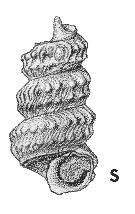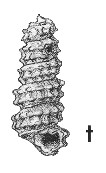
Revised descriptions of New Zealand Cenozoic Mollusca from Beu and Maxwell (1990)

 | Revised descriptions of New Zealand Cenozoic Mollusca from Beu and Maxwell (1990) | 
|
  (Pl. 9s): GS329, G45/f8491, Pomahaka River, Duntroonian? (GNS) |
  (Pl. 9t): GS329, G45/f8491, Pomahaka River, Duntroonian? (GNS) |
Beu & Maxwell (1990): Chapter 10; p. 140; pl. 9 s, t.
Synonymy: Turritella ornata Hutton 1873b, p. 13 (not of d'Orbigny, 1843, nor of Michelotti, 1847); Batillona amara Finlay 1927b, p. 496 (new name for Turritella ornata Hutton, preoccupied); Epitonium (Acirsa) ornatum
Type species of Batillona Finlay, 1927
Classification: Potamididae?
Description: Rather small for family (height c. 10 mm), turriculate, protoconch not known, early teleoconch whorls missing from most shells. Teleoconch whorls strongly biangulate at about 0.3 and 0.7 whorl height; last whorl with well defined peribasal keel, base almost flat. Axial sculpture, apart from opisthocyrt growth lines, of weak opisthocline costae connecting prominent nodules on the whorl angles, costae becoming obsolete and nodules becoming more crowded and comma- shaped on the last whorl of some shells. Spiral sculpture of narrow, low cords on shoulder angles, becoming obsolete on later whorls of large shells; a thin ridge marking the peribasal angle. Aperture incompletely preserved on all specimens examined, but apparently subcircular, without a definite siphonal canal; columella concave, inner lip bounded by a narrow ridge that enters aperture. Outer lip apparently thin with a deep rounded sinus posteriorly, its apex slightly above posterior keel, strongly opisthocline below to peribasal keel, and prosocyrt (convex) on base.
Comparison: The affinities of this little gastropod are uncertain; although long included in the Potamididae, the absence of a definite siphonal canal and the shape of the outer lip possibly rule out assignment to that family. The apertural characters, particularly the deep anal sinus and prosocyrt basal lip, and the thin columellar ridge suggested to Beu & Maxwell (1990, p. 141) that a provisional location in the Pareoridae near Pareora (see Pl. 55c, f, g) might be appropriate, although the strongly biangulate whorls and the presence of axial sculpture set it apart from other members of the family. These characters indicate that the original position in Potamididae is more likely to be correct.
Distribution: Duntroonian(?), Pomahaka Formation, Pomahaka River (type), locally very abundant.
Cite this publication as: "A.G. Beu and J.I. Raine (2009). Revised
descriptions of New Zealand Cenozoic Mollusca from Beu and Maxwell (1990). GNS
Science miscellaneous series no. 27."
© GNS Science, 2009
ISBN
978-0-478-19705-1
ISSN 1177-2441
(Included with a PDF facsimile file
copy of New Zealand Geological Survey Paleontological Bulletin 58 in CD version
from: Publications Officer, GNS Science, P.O. Box 30368 Lower Hutt, New
Zealand)